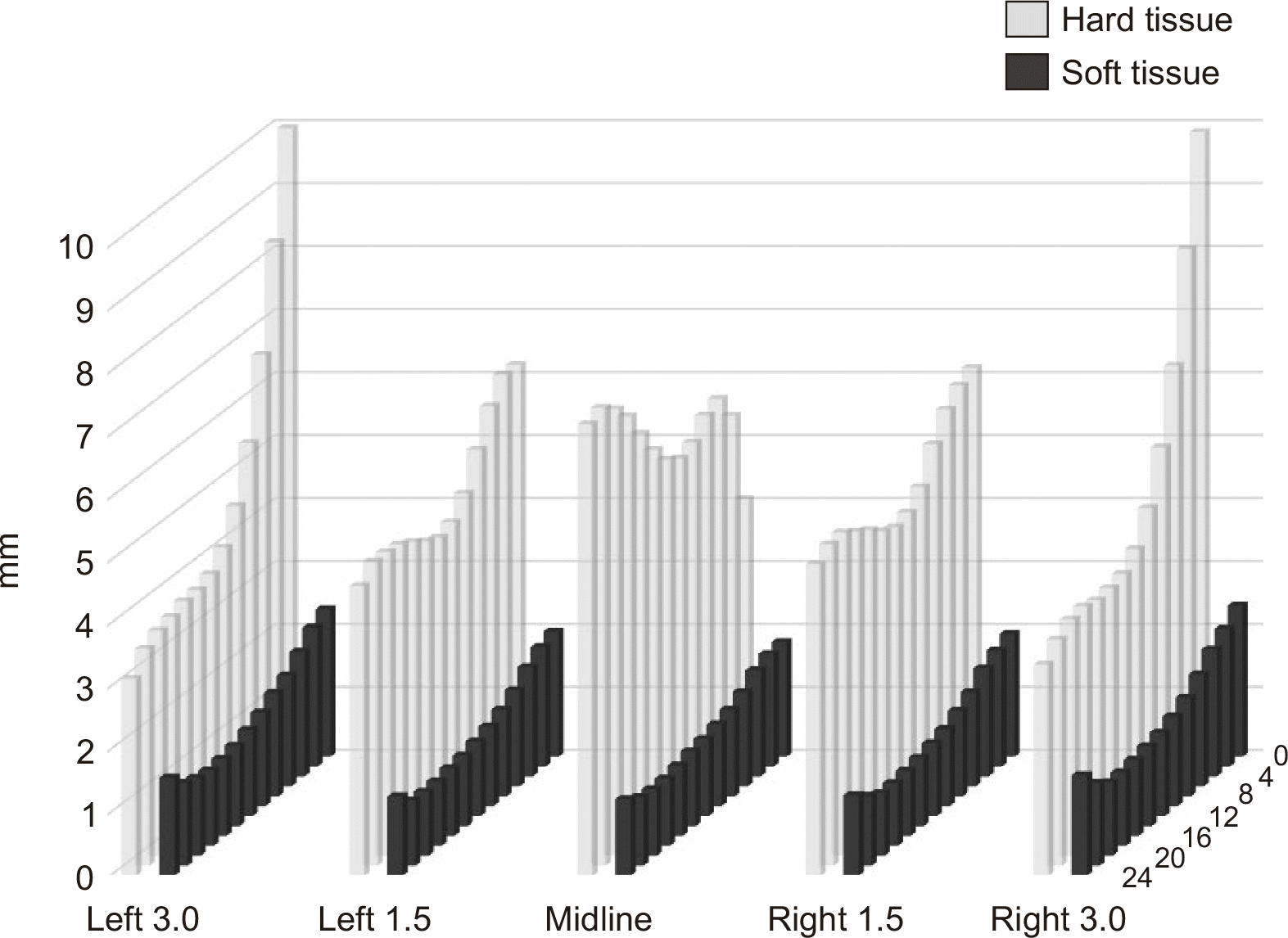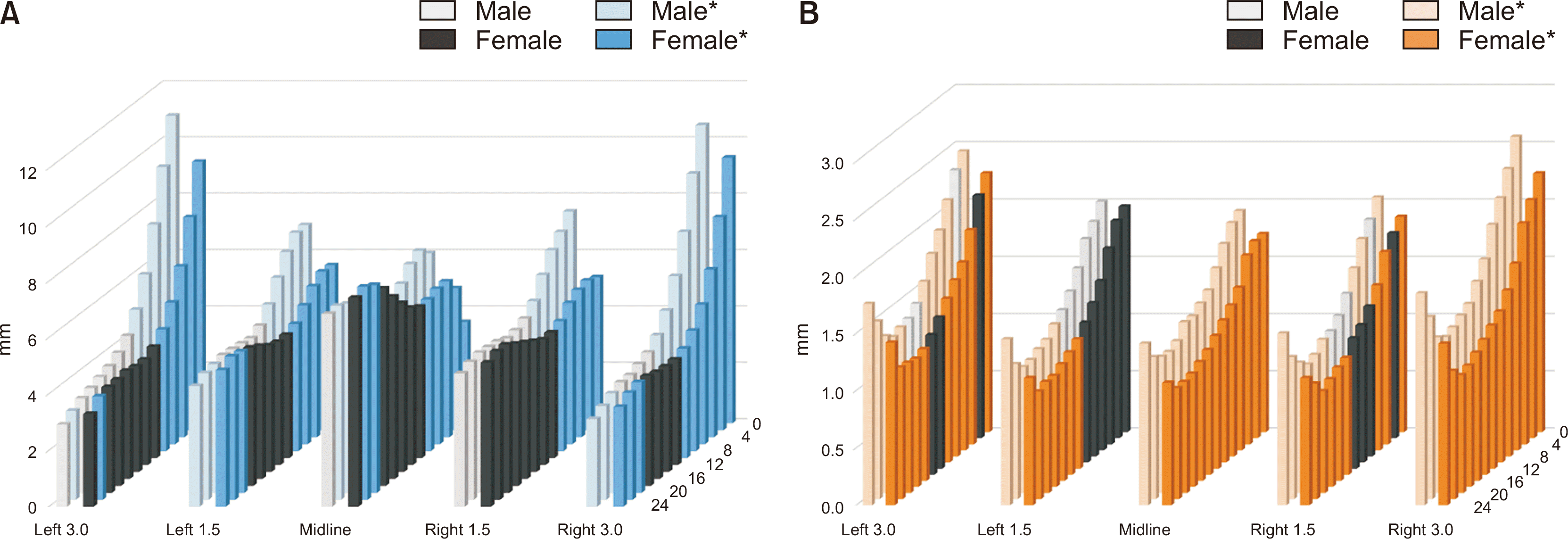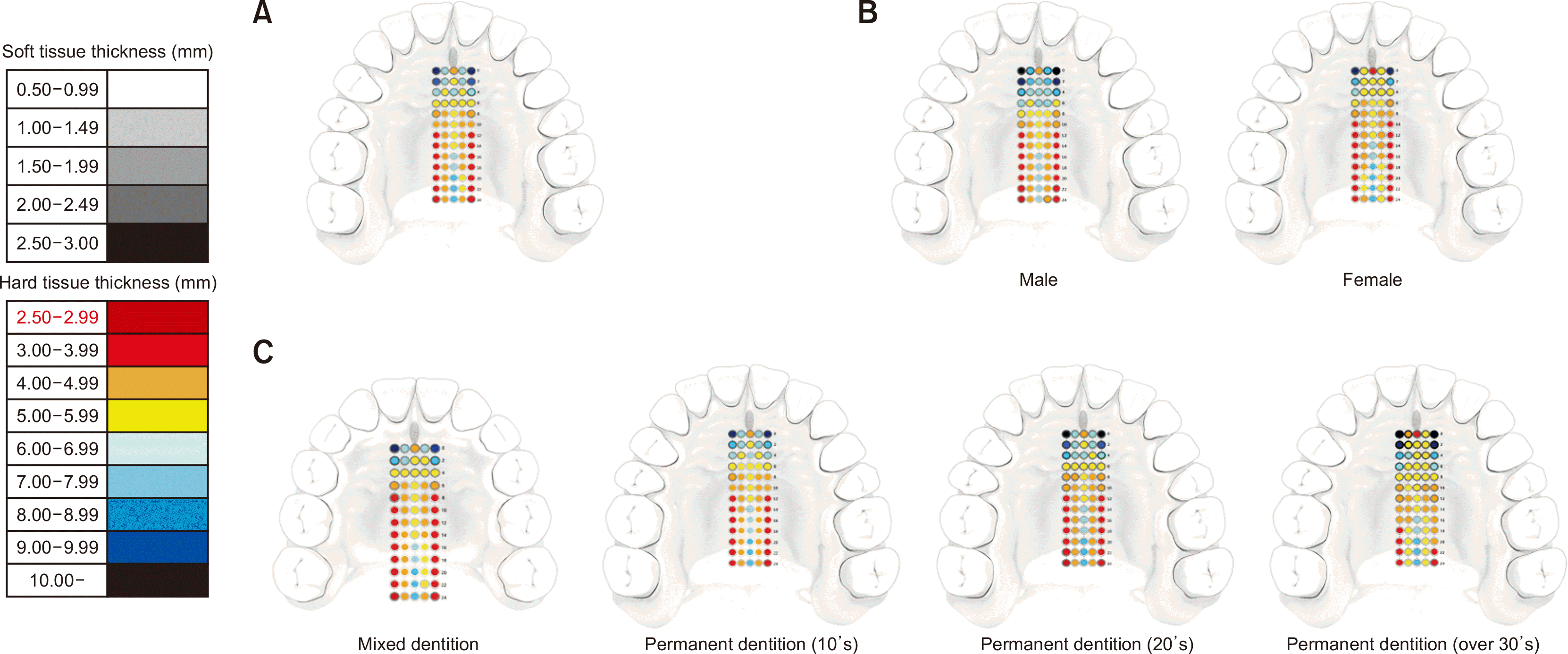INTRODUCTION
MATERIALS AND METHODS
Subjects
Table 1
Measurement
 | Figure 1
A, A schematic illustration of the area for measuring the hard tissue and soft tissue thicknesses of the palate (so-called I-bar). B, Measuring grid for the palatal hard and soft tissue heights at the 65 evaluated sites, starting from the posterior border of the incisive foramen (occlusal view). C, Reference points and lines for measuring the palatal hard and soft tissue heights (sagittal view).
AP, anterior-posterior; ML, midline-lateral.
|
 | Figure 2A sagittal section of a cone-beam computed tomography image of the palate. The image shows the measurement of the height of the soft (A) and hard (B) tissues of the palate at one reference point (the midpalatal suture [ML = 0], 4 mm from incisive foramen posteriorly [AP = 4]).
AP, anterior-posterior; ML, midline-lateral.
|
Statistical analysis
RESULTS
 | Figure 3Mean palatal hard and soft tissue thicknesses (mm) at the 65 evaluated sites.
Midline, the line at the midpalatal suture; Left 1.5 and 3.0, the lines from left 1.5 and 3.0 mm from the midline; Right 1.5 and 3.0, the lines from right 1.5 and 3.0 mm from the midline.
|
 | Figure 4Mean palatal hard (A) and soft (B) tissue thicknesses (mm) at the 65 evaluated sites in male and female patients. Hard and soft tissue thicknesses showing significant sex-related differences (*) are marked in blue and orange color, respectively.
Midline, the line at the midpalatal suture; Left 1.5 and 3.0, the lines from left 1.5 and 3.0 mm from the midline; Right 1.5 and 3.0, the lines from right 1.5 and 3.0 mm from the midline. In each line, the left and right rows indicate thickness in male and female patients, respectively.
|
Table 2
Midline, midpalatal suture line; Left 1.5 and 3.0, lines marked 1.5 and 3.0 mm from the midpalatal suture, respectively, on the left side; Right 1.5 and 3.0, lines marked 1.5 and 3.0 mm from the midpalatal suture, respectively, on the right side; Anterior, area from 0 to 8 mm; Middle, area from 10 to 16 mm; Posterior, area from 18 to 24 mm.
Table 3
| Midline-Lateral | Sex | Hard tissue | Soft tissue | |||||
|---|---|---|---|---|---|---|---|---|
| Anterior | Middle | Posterior | Anterior | Middle | Posterior | |||
| Left 3.0 | Male | 7.77 ± 2.31 | 3.92 ± 1.46 | 3.22 ± 1.24 | 2.12 ± 0.71 | 1.43 ± 0.60 | 1.50 ± 0.69 | |
| Female | 6.45 ± 2.09 | 3.81 ± 1.39 | 3.62 ± 1.28 | 1.89 ± 0.55 | 1.28 ± 0.50 | 1.21 ± 0.50 | ||
| Adjusted p-value | 0.0006*** | 0.3413 | 0.1643 | 0.0068** | 0.0675 | 0.0096** | ||
| Left 1.5 | Male | 6.34 ± 1.77 | 4.59 ± 1.49 | 4.49 ± 1.45 | 1.75 ± 0.54 | 1.23 ± 0.43 | 1.21 ± 0.50 | |
| Female | 5.21 ± 1.74 | 4.49 ± 1.39 | 4.96 ± 1.43 | 1.68 ± 0.64 | 1.11 ± 0.50 | 1.00 ± 0.54 | ||
| Adjusted p-value | 0.0006*** | 0.4515 | 0.1017 | 0.2242 | 0.1643 | 0.0189* | ||
| Midline | Male | 6.00 ± 1.31 | 5.93 ± 1.74 | 6.75 ± 2.22 | 1.72 ± 0.49 | 1.32 ± 0.37 | 1.25 ± 0.55 | |
| Female | 5.01 ± 1.27 | 5.85 ± 1.55 | 7.34 ± 1.80 | 1.57 ± 0.51 | 1.13 ± 0.36 | 1.00 ± 0.41 | ||
| Adjusted p-value | 0.0006*** | 0.8673 | 0.0687 | 0.0092** | 0.0009*** | 0.0021** | ||
| Right 1.5 | Male | 6.49 ± 1.79 | 4.83 ± 1.66 | 4.87 ± 1.97 | 1.75 ± 0.51 | 1.19 ± 0.40 | 1.24 ± 0.65 | |
| Female | 5.07 ± 1.59 | 4.60 ± 1.41 | 5.17 ± 1.68 | 1.62 ± 0.50 | 1.09 ± 0.38 | 0.99 ± 0.47 | ||
| Adjusted p-value | 0.0006*** | 0.2133 | 0.5365 | 0.0180* | 0.0675 | 0.0035** | ||
| Right 3.0 | Male | 7.58 ± 2.25 | 3.96 ± 1.48 | 3.41 ± 1.47 | 2.15 ± 0.70 | 1.44 ± 0.50 | 1.53 ± 0.83 | |
| Female | 6.43 ± 2.22 | 3.79 ± 1.40 | 3.79 ± 1.32 | 1.87 ± 0.49 | 1.22 ± 0.38 | 1.16 ± 0.51 | ||
| Adjusted p-value | 0.0009*** | 0.2535 | 0.1150 | 0.0006*** | 0.0010** | 0.0010** | ||
Midline, midpalatal suture line; Left 1.5 and 3.0, lines marked 1.5 and 3.0 mm from the midpalatal suture, respectively, on the left side; Right 1.5 and 3.0, lines marked 1.5 and 3.0 mm from the midpalatal suture, respectively, on the right side; Anterior, area from 0 to 8 mm; Middle, area from 10 to 16 mm; Posterior, area from 18 to 24 mm.
Table 4
| Midline-Lateral |
Age group |
Hard tissue | Soft tissue | |||||
|---|---|---|---|---|---|---|---|---|
| Anterior | Middle | Posterior | Anterior | Middle | Posterior | |||
| Left 3.0 | 1 | 6.16 ± 1.77a | 3.49 ± 1.16 | 3.35 ± 1.17 | 1.93 ± 0.52 | 1.24 ± 0.45 | 1.30 ± 0.60 | |
| 2 | 6.63 ± 2.00b | 3.86 ± 1.29 | 3.52 ± 1.17 | 1.86 ± 0.60a | 1.30 ± 0.59 | 1.21 ± 0.50 | ||
| 3 | 7.45 ± 2.46 | 3.81 ± 1.69 | 3.22 ± 1.46 | 2.01 ± 0.72b | 1.38 ± 0.59 | 1.50 ± 0.76 | ||
| 4 | 8.08 ± 2.58ab | 4.27 ± 1.42 | 3.73 ± 1.29 | 2.31 ± 0.60ab | 1.47 ± 0.45 | 1.39 ± 0.65 | ||
| Adjusted p-value | 0.0013** | 0.1151 | 0.5074 | 0.0068** | 0.3917 | 0.3703 | ||
| Left 1.5 | 1 | 5.37 ± 1.74 | 4.27 ± 1.18 | 4.82 ± 1.34 | 1.55 ± 0.35a | 1.02 ± 0.29 | 1.00 ± 0.53 | |
| 2 | 5.67 ± 1.77 | 4.45 ± 1.29 | 4.72 ± 1.36 | 1.55 ± 0.60b | 1.06 ± 0.52a | 0.99 ± 0.45 | ||
| 3 | 6.00 ± 2.03 | 4.56 ± 1.66 | 4.56 ± 1.58 | 1.75 ± 0.55c | 1.29 ± 0.50 | 1.24 ± 0.53 | ||
| 4 | 5.58 ± 1.77 | 4.92 ± 1.54 | 5.11 ± 1.56 | 2.18 ± 0.63abc | 1.34 ± 0.40a | 1.17 ± 0.48 | ||
| Adjusted p-value | 0.6924 | 0.3083 | 0.7661 | 0.0005*** | 0.0066** | 0.1152 | ||
| Midline | 1 | 5.33 ± 1.26 | 5.73 ± 1.35 | 7.14 ± 1.91 | 1.52 ± 0.31a | 1.07 ± 0.25ab | 0.99 ± 0.56 | |
| 2 | 5.54 ± 1.38 | 5.91 ± 1.51 | 7.04 ± 1.75 | 1.44 ± 0.37b | 1.08 ± 0.28cd | 0.99 ± 0.37a | ||
| 3 | 5.48 ± 1.49 | 6.01 ± 1.97 | 7.09 ± 2.43 | 1.71 ± 0.43c | 1.34 ± 0.40ace | 1.26 ± 0.52 | ||
| 4 | 5.23 ± 1.29 | 5.79 ± 1.63 | 7.16 ± 2.03 | 2.10 ± 0.69abc | 1.48 ± 0.45bde | 1.27 ± 0.53a | ||
| Adjusted p-value | 0.6967 | 0.9347 | 0.9347 | 0.0005*** | 0.0005*** | 0.0068** | ||
| Right 1.5 | 1 | 5.38 ± 1.46 | 4.58 ± 1.47 | 5.11 ± 2.01 | 1.52 ± 0.33a | 0.98 ± 0.22a | 1.05 ± 0.76 | |
| 2 | 5.80 ± 2.06 | 4.66 ± 1.28 | 4.90 ± 1.31 | 1.51 ± 0.37b | 1.02 ± 0.34bc | 0.96 ± 0.33a | ||
| 3 | 5.81 ± 1.77 | 4.69 ± 1.89 | 4.89 ± 2.15 | 1.73 ± 0.45c | 1.22 ± 0.44b | 1.17 ± 0.50 | ||
| 4 | 5.48 ± 1.61 | 4.93 ± 1.51 | 5.55 ± 2.06 | 2.14 ± 0.69abc | 1.39 ± 0.40ac | 1.35 ± 0.78a | ||
| Adjusted p-value | 0.5060 | 0.4925 | 0.4301 | 0.0005*** | 0.0005*** | 0.0037** | ||
| Right 3.0 | 1 | 6.08 ± 1.68a | 3.48 ± 1.21 | 3.42 ± 1.33 | 1.82 ± 0.38a | 1.17 ± 0.24a | 1.33 ± 0.91 | |
| 2 | 6.72 ± 2.19b | 3.86 ± 1.23 | 3.57 ± 1.10 | 1.86 ± 0.46b | 1.23 ± 0.41b | 1.22 ± 0.48 | ||
| 3 | 7.26 ± 2.47 | 3.89 ± 1.83 | 3.68 ± 1.81 | 2.07 ± 0.75c | 1.40 ± 0.51 | 1.41 ± 0.62 | ||
| 4 | 7.72 ± 2.56ab | 4.22 ± 1.34 | 3.88 ± 1.34 | 2.37 ± 0.66abc | 1.51 ± 0.51ab | 1.41 ± 0.94 | ||
| Adjusted p-value | 0.0235* | 0.1652 | 0.4070 | 0.0005*** | 0.0037** | 0.3917 | ||
Superscript lowercase letters in the same column indicate statistically significant differences between the groups.
Midline, midpalatal suture line; Left 1.5 and 3.0, lines marked 1.5 and 3.0 mm from the midpalatal suture, respectively, on the left side; Right 1.5 and 3.0, lines marked 1.5 and 3.0 mm from the midpalatal suture, respectively, on the right side; Anterior, area from 0 to 8 mm; Middle, area from 10 to 16 mm; Posterior, area from 18 to 24 mm; Age group 1, mixed dentition; Age group 2, permanent dentition (10's); Age group 3, permanent dentition (20's); Age group 4, permanent dentition (over 30's).
DISCUSSION
 | Figure 5Mean palatal hard and soft tissue thicknesses (mm) at the 65 evaluated sites were marked with a target shape. The inner circle color indicated the thickness of the hard tissue, and the outer circle color indicated the thickness of the soft tissue, referring to the color scale bar on the left. A, Whole group. B, Male and female groups. C, Mixed and permanent dentition groups. |




 PDF
PDF Citation
Citation Print
Print



 XML Download
XML Download